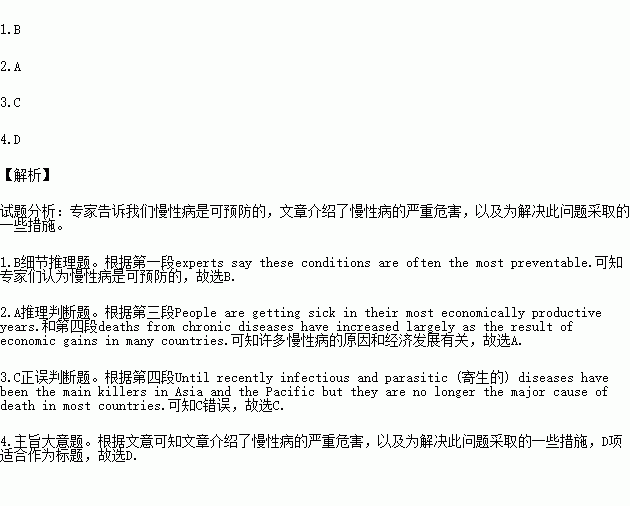题目内容
Such chronic (慢性的) diseases as heart disease, stroke, cancer and lung disorders are the most leading causes of death in the world. Yet health experts say these conditions are often the most preventable.
The World Health Organization (WHO) points out chronic diseases lead to about 17 million early deaths each year. The United Nations (UN) agency expects more than 380 million people to die of chronic diseases by 2015. About 80% of the deaths will happen in developing nations.
Chronic diseases now cause two-thirds of all deaths in the Asia-Pacific area. In ten years it could be almost three-fourths. People are getting sick in their most economically productive years. In fact, chronic diseases are killing more middle-aged people in poorer countries than in richer ones. The WHO estimates (估计) that chronic diseases will cost China alone more than 500,000 million dollars in the next ten years. That estimate represents the costs of medical treatment and lost productivity. Russia and India are also expected to face huge economic losses.
According to a WHO report, deaths from chronic diseases have increased largely as the result of economic gains in many countries. Until recently infectious and parasitic (寄生的) diseases have been the main killers in Asia and the Pacific but they are no longer the major cause of death in most countries.
As many as 80% of the deaths from chronic diseases could be prevented, health officials say. An important tool for governments is to limit the marketing of alcohol and tobacco to young people. Also, more programs are needed to urge healthy eating and more physical activity.
The UN aims to reduce chronic-disease deaths by 2% each year by international action through 2015, that’s to say, 36 million lives could be saved, including 25 million in Asia and the Pacific.
1.According to the passage, chronic diseases ________.
A. can be ignored B. can be prevented
C. will disappear D. are all deadly
2.In many countries, what’s mainly responsible for increasing deaths from chronic diseases?
A. The economic development.
B. The poor living conditions.
C. Infectious and parasitic diseases.
D. Young people’s bad habits.
3.Which of the following statements is NOT true?
A. Most deaths are caused by chronic diseases in the world.
B. The middle-aged are becoming victims of chronic diseases in Asia.
C. Infectious and parasitic diseases are no longer death killers.
D. To reduce chronic-disease deaths needs worldwide efforts.
4.The best title for the passage would be “________”.
A. Different Measures to Fight Chronic Diseases
B. The WHO’s Report on Heath in Developing Countries
C. The UN: the Leader of International Community
D. Chronic Diseases: the World’s Leading Killer
 优质课堂快乐成长系列答案
优质课堂快乐成长系列答案
